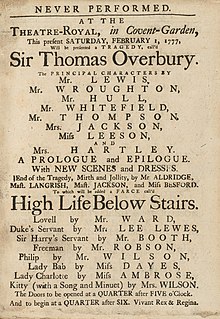Related Research Articles
The Natural Son is a comedy play by the British writer Richard Cumberland. It was first staged at the Drury Lane Theatre in London in December 1784. The play is notable for the return of the popular character Major O'Flaherty from Cumberland's 1771 play The West Indian.
Busiris, King of Egypt is a 1719 tragedy by the British writer Edward Young. It is set in Ancient Egypt during the reign of Busiris. It was considered a success, enjoying a good run and was subsequently published by Jacob Tonson.
The Revenge is a 1721 tragedy by the British writer Edward Young. Although initially it did not enjoy the same success as his previous play Busiris, King of Egypt, it later became a much-revived work during the eighteenth century particularly popular because of the Othello-like role of the Moorish character Zanga. John Philip Kemble revived the work briefly in 1798 before Edmund Kean in 1815 did so with great success and it became part of his repertoire.
The Siege of Aquileia is a 1760 tragedy by the British writer John Home. It is set around the time of the Siege of Aquileia during the Roman Empire.
Wexford Wells is a 1720 comedy play by the Irish writer Matthew Concanen.
Elmerick, or Justice Triumphant is a 1740 tragedy by the British writer George Lillo. It was performed posthumously following his death the year before. It portrays the rivalry between the medieval Hungarian brothers Emeric, King of Hungary and Andrew II.
The Christian Hero is a 1735 tragedy by the British writer George Lillo. It is based on the life of Skanderbeg who led a rebellion against the Ottoman Empire in the fifteenth century. Two years earlier William Havard had written Scanderbeg, another work based on his life.
Scanderbeg, A Tragedy is a 1733 tragedy by the British writer William Havard. It is based on the life of Skanderbeg who led a rebellion against the Ottoman Empire in the fifteenth century. Another play about him George Lillo's The Christian Hero was produced two years later.
Sophonisba is a 1730 tragedy by the British writer James Thomson. It is based on the story of the Carthaginian noblewoman Sophonisba who committed suicide rather than be paraded in a Roman triumph at the end of the Second Punic War. The story has been made into a number of plays including Nathaniel Lee's restoration tragedy Sophonisba and Voltaire's later Sophonisbe.
Art and Nature is a 1738 comedy play by the British writer James Miller. The play received a rough reception from what Miller described a "faction" in the Drury Lane audience, and its run was not extended beyond a single night. He described its subsequent publication as an attempt to vindicate himself.
The Coffee House is a 1738 comedy play by the British writer James Miller, written as an afterpiece. After being performed at Drury Lane, it was published later that year with some alterations to the play's original text.
Agamemnon is a 1738 tragedy by the British writer James Thomson. It is based on the story of Agamemnon from Greek Mythology.

The Way to Keep Him is a 1760 comedy play by the Irish writer Arthur Murphy. Originally three-acts in length, it premiered at the Drury Lane Theatre in a double bill with Murphy's The Desert Island. Actor-manager David Garrick appeared in both productions. A great success, the following year it was extended to five acts, with music composed by Thomas Arne to accompany it. It had many revivals well into the nineteenth century.
The Roman Father is a 1750 tragedy by the British writer William Whitehead. It is set during the reign of Tullus Hostilius, the legendary third King of Rome and his war with the neighbouring city of Alba Longa.
Creusa, Queen of Athens is a 1754 tragedy by the British writer William Whitehead. It is based on the story of Creusa of Athens.

The School for Lovers is a 1762 comedy play by the British writer William Whitehead.
The Foundling is a 1748 comedy by the British writer Edward Moore.
Gil Blas is a 1751 comedy play by the British writer Edward Moore. It is based on the novel Gil Blas by French writer Alain-René Lesage.

High Life Below Stairs is a 1759 comedy play by the British writer James Townley. An afterpiece, it premiered at Drury Lane on a double bill with a revival of Dryden's The Mourning Bride. A popular hit, it was frequently revived.
The School for Rakes is a 1769 comedy play by the British writer Elizabeth Griffith. It was inspired by thr 1767 French play Eugénie by Pierre Beaumarchais.